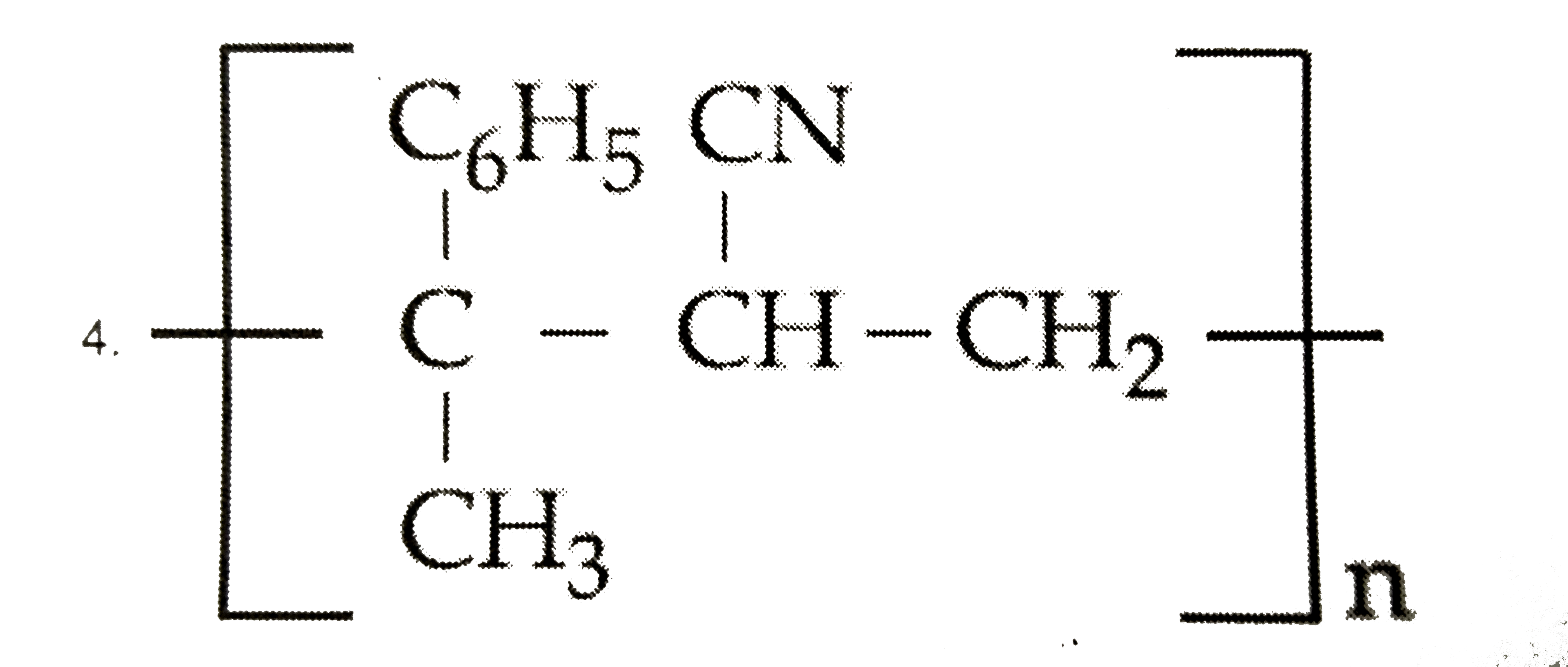The copolymer formed by addition polymerization of styrene and acrylonitrile in the presence of peroxide is :




The correct Answer is:C
To determine the copolymer formed by the addition polymerization of styrene and acrylonitrile in the presence of peroxide, we can follow these steps:
Step 1: Identify the Monomers
The two monomers involved in this copolymerization are:
- Styrene (C₈H₈), which has a vinyl group (C=C).
- Acrylonitrile (C₃H₃N), which also has a vinyl group and contains a nitrile functional group (-C≡N).
Step 2: Understand the Polymerization Process
Addition polymerization involves the reaction of monomers that contain double bonds. In the presence of a peroxide, the double bonds in styrene and acrylonitrile can initiate the polymerization process. Peroxides serve as radical initiators, breaking down to form free radicals that can react with the monomers.
Step 3: Reaction Mechanism
1. Initiation: The peroxide decomposes to form free radicals.
2. Propagation: The free radicals react with the double bond of styrene and acrylonitrile, forming a new radical that can react with more monomers.
3. Termination: The reaction continues until the radicals combine or terminate.
Step 4: Copolymer Structure
The copolymer formed from the polymerization of styrene and acrylonitrile is known as Acrylonitrile-Butadiene-Styrene (ABS). However, in this case, since we are only considering styrene and acrylonitrile, the copolymer will be a random copolymer of styrene and acrylonitrile.
Step 5: Final Product
The final product will be a copolymer consisting of alternating or random units of styrene and acrylonitrile, which can be represented as:
- (Styrene)n-(Acrylonitrile)m
Conclusion
The copolymer formed by the addition polymerization of styrene and acrylonitrile in the presence of peroxide is a styrene-acrylonitrile copolymer (SAN).
---
The two monomers involved in this copolymerization are:
- Styrene (C₈H₈), which has a vinyl group (C=C).
- Acrylonitrile (C₃H₃N), which also has a vinyl group and contains a nitrile functional group (-C≡N).
Addition polymerization involves the reaction of monomers that contain double bonds. In the presence of a peroxide, the double bonds in styrene and acrylonitrile can initiate the polymerization process. Peroxides serve as radical initiators, breaking down to form free radicals that can react with the monomers.
1. Initiation: The peroxide decomposes to form free radicals.
2. Propagation: The free radicals react with the double bond of styrene and acrylonitrile, forming a new radical that can react with more monomers.
3. Termination: The reaction continues until the radicals combine or terminate.
The copolymer formed from the polymerization of styrene and acrylonitrile is known as Acrylonitrile-Butadiene-Styrene (ABS). However, in this case, since we are only considering styrene and acrylonitrile, the copolymer will be a random copolymer of styrene and acrylonitrile.
The final product will be a copolymer consisting of alternating or random units of styrene and acrylonitrile, which can be represented as:
- (Styrene)n-(Acrylonitrile)m
The copolymer formed by the addition polymerization of styrene and acrylonitrile in the presence of peroxide is a styrene-acrylonitrile copolymer (SAN).
Topper's Solved these Questions
Similar Questions
Knowledge Check
the addition of HBr to an alkene in the presence of a peroxide is
Aa nucleophilic addition via an alkyl anoin intermediateBan electrophilic addition via an alkyl cation intermediateCa free-radical addition via a β-bromo alkyl radical intermediateDa free-radical addition via an α-bromo alkyl radical intermediateThe product of addition polymerization reaction is:
APVCBnylonCteryleneDpolyamideThe major product obtained by the addition reaction of HBr to 4-methylpent-1-ene in the presence of peroxide is:
A1-bromo-4-methylpentaneB4-bromo-2-methylpentaneC3-bromo-2-methylpentaneD2-bromo-2-methylpentane
Addition of HBr to propylene in presence of benzoyl peroxide, follows :
View SolutionAddition of HBr to propylene in presence of benzoyl peroxide, follows :
View SolutionThe intermediate during the addition of HCl to propene in the presence of peroxide is:
View SolutionThe intermediate during the addition of HCl to propene in the presence of peroxide is :
View SolutionThe intermediate during the addition of HCl to propene in the presence of peroxide is :
View Solution
